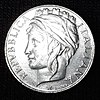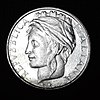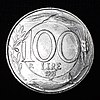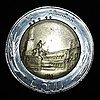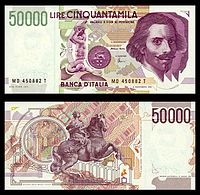Italian lira
The Italian lira (Italian plural lire, currency symbol: ₤) was the official currency of Italy from 1861 to 2002 before the introduction of the Euro on 1 January of 2002, being definitively replaced by this one. The fixed exchange rate was 1,936.27 lire for each euro.
The lira was also the official currency of the Napoleonic Kingdom of Italy, between 1807 and 1814.
The term comes from the value of the physical weight of a pound of high purity silver, keeping a direct relationship with the pound sterling; In some countries, such as Cyprus and Malta, the words lira and pound were used interchangeably, before the euro was approved in 2008 in both countries.
History
The lyre dates back to before Charlemagne. Like the pound sterling, it represented one pound weight of silver, and was equivalent to 20 soldi or 240 denari. Before unification, many of the Italian states used the lira as their official currency.
In 1807, the Napoleonic Kingdom of Italy, which occupied the northeast of present-day Italian territory, introduced the lira as its currency. Equal to the French franc, it was divided into 20 soldi or 100 centesimi. This lira circulated until 1814 when the kingdom broke up.
After the creation of the Kingdom of Italy under the rule of Victor Emmanuel II in 1861, a lira was established, at 4.5 g of silver or 290.322 milligrams of gold. This was a direct continuation of the lire used in the Kingdom of Sardinia. Other currencies that were replaced by the Italian lira were the Lombardy guilder, the Two Sicilian piastra, the Tuscany fiorino, the papal escutcheon, and the Parma lira. In 1865, Italy was part of the Latin Monetary Union, establishing a parity between its value and that of the French franc, the Swiss franc and the Belgian franc.
World War I broke up the Latin Monetary Union, resulting in a general price increase in Italy. Inflation was partially stopped by the then dictator Benito Mussolini, who on August 18, 1926, established that the exchange rate between liras and pounds would be £1 = 90 liras —the so-called Quota 90-, although the real exchange rate had been close to 140-150 lire per pound. In 1927 one US dollar was equal to 19 lire. This exchange rate lasted until 1934, with a separate exchange rate for tourists of US$1 = 24.89 lira. In 1939, the official exchange rate was 19.8 lire to the dollar.
After the Allied invasion of Italy in June 1943, the exchange rate was fixed at US$1 = 120 lire (1 British pound = 480 lire), reduced to 100 lire the following month. In German-occupied areas, the exchange rate was set at 1 reichsmark = 10 lire. After the war, the value of the lira fluctuated, until it fixed a parity of US$1 = 575 liras within the Bretton Woods system in November 1947. On September 21, 1949, it was devalued to 625 liras per dollar. This rate was maintained until the end of the Bretton Woods system in the 1970s. Several inflationary episodes occurred in the following years, until the lira was replaced by the euro.
The lira was the official currency of Italy until January 1, 1999, when it was replaced by the euro. The currency lira ceased to be legal on February 28, 2002. The conversion rate was 1,936.27 lire per euro. All banknotes in use immediately before the introduction of the euro were exchangeable for euros at the Bank of Italy until February 29, 2012, after which time this currency became worthless.
Renaming
Although Italian banknotes became difficult to use due to the large number of zeros, redenomination efforts did not come to fruition for political reasons until the introduction of the euro, which has had the effect of removing too many zeros.
Coins
Napoleonic period
During the Napoleonic Kingdom of Italy, coins were minted between 1807 and 1813 in the denominations of 1 and 3 hundredths, and a copper salary; 10 hundredths with 20% silver, 5, 10 and 15 salaries; and 1, 2 and 5 lire with 90% silver, and 20 and 40 lire with 90% gold. All but the 10 cent coin bore Napoleon's portrait; denominations of less than 1 lira had a radiated crown in their design, and larger denominations a shield with the different territories that made up the Kingdom.
Kingdom of Italy (1861-1946)
In 1861, coins were minted at the mints of Florence, Milan, Naples, and Turin in denominations of 1, 2, 5, 10, and 50 cents, and 1, 2, 5, 10, and 20 lire. The lowest value coins were minted in copper, and the rest in precious metals. In 1863, coins of less than 5 liras reduced their amount of silver from 90% to 83.50%, in addition to introducing 20-cent coins. In the 1970s all the mints in Rome were unified.
Apart from the introduction of cupronickel 20-hundredths in 1894 and nickel 25-hundredths in 1902, the monetary cone remained largely unchanged until World War I
In 1919, with a devaluation of the lira reduced to one-fifth of its strength in 1914, production of 20-cent coins stopped and new, smaller-sized coins were minted in denominations of 5, 10, and 50 cents, followed of coins of 1 and 2 lire in 1922 and 1923, respectively. In 1926, silver coins of 5 and 10 lire were minted with the same size as the previous 1 and 2 lire coins. In 1927 silver 20 lire coins were introduced.
In 1936 a last series of silver coins was minted, while in 1939 the high cost of copper led to the minting of brass and nickel coins. In 1943 all coinage stopped.
Republic (1946-2002)
In 1946 coins were partially restored, although only in 1948, with a devaluation of currencies 1/50{displaystyle 1/50} In 1939, the number of coins coined exceeded one million pieces. To begin with, four aluminum designations of 1, 2, 5 and 10 lire were coined. These coins circulated along with the special coins of the ally band (AM-Lira) and some of the devalued coins of the monarchical period. In 1951 the government decided to replace all coins and bills with new sizes reduced in denominations of 1, 2, 5 and 10 lire of aluminum (although the currency of 2 lire did not begin to coin between 1951-1952) and in 1954-1955, acmonital coins were introduced in denominations of 50 and 100 lire, followed by those of 20 lire of bronze-aluminium in 1957 and the silver of 500 lire. Due to the high price of silver only a small number of coins were coined for collectors after 1967.
Aluminium-bronze 200 lire denominations were introduced in 1977, followed in 1982 by bimetallic 500 lire coins. This type of coin was the first to be minted, using a system patented by the Zecca dello Stato. They were also the first coins to introduce their denomination in the Braille alphabet.
Production of the 1 and 2 lira coins ceased in 1959, but they were minted again from 1982 to 2001 for collectors. The production of 5 lira coins was reduced at the end of the 1970s and ceased to circulate in 1998. Similarly, in 1991 the production of 10 and 20 lira coins was limited, also for collectors. The sizes of the 50 and 100 lira coins were reduced in 1990, but in 1993 they were increased again and their design changed. Finally, between 1997 and 1998, a bimetallic 1,000 lire coin was minted.
Before the adoption of the euro in Italy, the denominations that circulated were the following:
Tickets
In 1882 the government began issuing small paper securities under the name Biglietto dello Stato. These were printed in denominations of 5 and 10 lire, and occasionally those of 25 lire from 1895. Notes under the name Buono di Cassa were also issued between 1893 and 1922 in denominations of 1 and 2 lire. The production of the Biglietti dello Stato ceased in 1925, but in 1935 it was resumed with denominations of 1, 2, 5 lire, and those of 10 lire in 1939.
The Banca d'Italia began printing banknotes in 1896 in denominations of 50, 100, 500 and 1,000 lire. Between 1918 and 1919, 25 lire notes were also issued, however, no changes were introduced until the end of World War II.
In 1943, the Allied side introduced 1, 2, 5, 10, 50, 100, 500 and 1,000 lire notes, followed in 1944 by a series of 1, 2 Biglietti dello Stato, 5 and 10 lire, which circulated until they were replaced by the coins of the last decade of the 1940s. In 1945, the Bank introduced 5,000 and 10,000 lire bills.
In 1951 the government reissued banknotes with the official name of the country: "Repubblica Italiana". The denominations were 50 and 100 lire, which replaced the issues of the Biglietti dello Stato, and which circulated until coins of those same denominations were minted in the 1950s. In 1966, 500-lire notes were introduced. liras that replaced the old Biglietti and were replaced by bimetallic coins in 1982.
In 1967, 50,000 and 100,000 lire notes were printed, followed by 20,000 lire denominations in 1975 and 500,000 lire in 1997.
Before the entry of the euro, the denominations that circulated were the following:
Currencies with parity set to the Italian lira
Vatican City
The Vatican lira was the official currency of Vatican City. It had its parity fixed to the Italian lira according to the economic treaties signed with Italy. Within Vatican City the Italian lira also circulated. Coins were minted in the Zecca dello Stato, with a more numismatic value than in common use among the population. Following the adoption of the euro by Italy, and with the economic agreements signed by both states, and with the approval of the European Commission, Vatican City also issues its own euros.
San Marino
The San Marino lira was the official currency of the Republic of San Marino. Like the Vatican lira, it had its parity fixed to the Italian lira according to the economic treaties signed with Italy. Likewise, the Italian lira was legal tender within its borders. Coins were minted in the Zecca dello Stato, for the same collecting purposes as the Vatican lira, and with Italy's adoption of the euro, like Vatican City, issues its own euro coins.
Contenido relacionado
Henri Fayol
Cuban music
Claude Nicolas Ledoux


